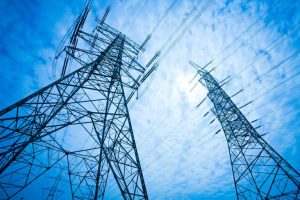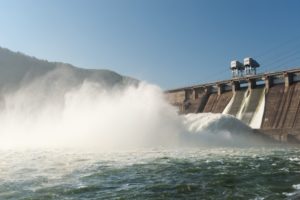What is Electricity?
![Model-of-atom [Converted]](https://energysafekids.org/bge-electric/wp-content/uploads/sites/15/2018/09/Model-of-atom-Converted-2.jpg)

Types of Electricity
 Static Electricity:
Static Electricity:
- Negative charges build up in the Earth’s atmosphere when there is a storm. The release of energy, as light and sound, is lightning. Those negative charges find a pathway to the ground or another object, like when people are released from a gate to find their seat on a roller coaster.
- Potential Energy:
- Energy waiting to be released, such as a lake or a pool of water in a reservoir behind a dam.
- Kinetic Energy:
Quick Facts
- Electricity is kinetic energy because electrons move or bump into each other as their negative charges flow to a circuit or an electric device.
Conductors and Insulators


Electricity flows through materials called conductors. Most metals are conductors of electricity, that is why wires are made of metals like copper and steel. Another conductor that many people do not think about is water.
Think of a time when you were swimming outside while a thunderstorm was approaching. Were you told to get out of the water? That is because there could be lightning and lightning is static electricity. It could strike the water and the electricity would flow through your body, which also means you are a good conductor of electricity!
Materials that do not conduct electricity well are called insulators. Some examples of insulators are wood, glass, plastic and rubber. The rubber or plastic coating on the wire protect us from the flow of electricity through our bodies.
How is Electricity Generated and Transmitted?
Electricity is a secondary energy source, which means it is generated from a primary source, usually a natural resource such as solar, oil, coal, natural gas, nuclear, water or wind. Most electricity in the United States comes from steam-powered generating plants that burn fossil fuels (coal, oil or natural gas) or use nuclear energy to heat water, thereby producing steam.
The steam spins a turbine, which is connected to a generator. The generator uses large magnets and coils of copper wire to create an electric current that is sent through the power lines, which can be above or below the ground.
Renewable resources can generate electricity as well. Hydropower, wind, solar, geothermal and biomass are sources that are used to generate electricity.


How is Electricity Used?


We use electricity in many ways everyday. There are four energy sectors in society: residential, commercial, industrial and transportation.
The largest single use of electricity in U.S. homes (residential sector) is for air conditioning followed by water heating, lighting, space heating, refrigeration, TVs and related electronic equipment, powering computers, and washing and drying clothes. (https://www.eia.gov/energyexplained/index.cfm?page=electricity_use)
In the U.S. commercial sector, lighting is the largest use of electricity. This includes retail, office, education, institutional, public and government buildings, as well as street lighting. The other major commercial uses of electricity are for cooling, ventilation, powering office equipment, and space and water heating.



